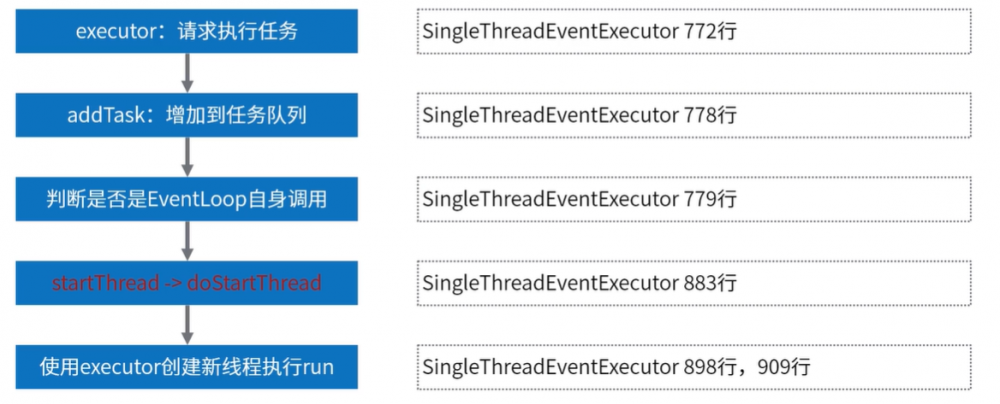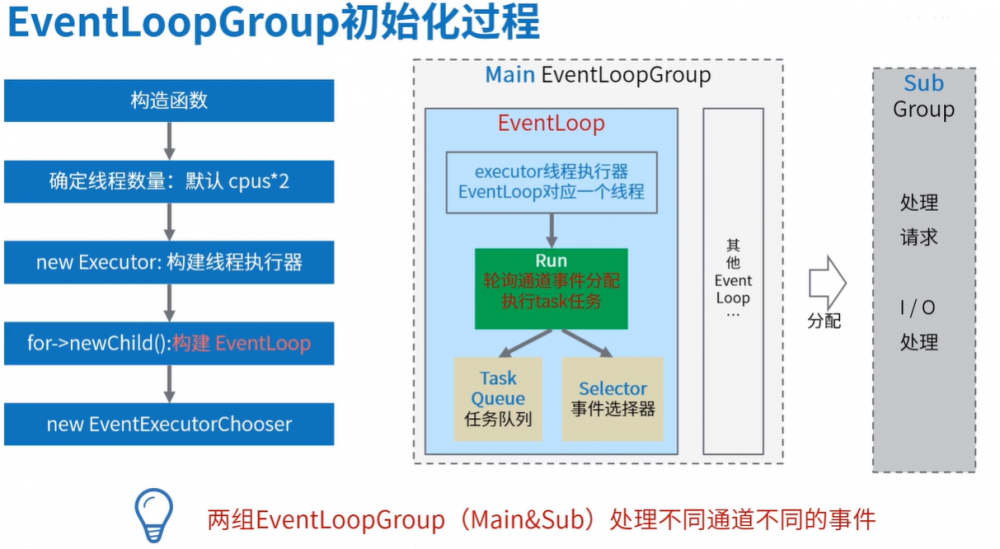Java网络编程--Netty入门
Netty是一个高性能,高可扩展性的异步事件驱动的网络应用程序框架,它极大的简化了TCP和UDP客户端和服务器端网络开发。它是一个NIO框架,对Java NIO进行了良好的封装。作为一个异步NIO框架,Netty的所有IO操作都是异步非阻塞的,通过Future-Listener机制,用户可以方便的主动获取或者通过通知机制获得IO操作结果。
Netty的特性
- 统一的API,适用于不同的协议
- 基于灵活、可扩展的事件驱动模型
- 高度可定制的线程模型
- 更好的吞吐量,低延迟
- 更省资源,尽量减少不必要的内存拷贝
- 完整的SSL/TLS和STARTTLS的支持
- 能在Applet与Android的限制环境运行良好
- 不再因过快、过慢或超负载连接导致OutOfMemoryError
- 不再有在高速网络环境下NIO读写频率不一致的问题
Netty核心内容
Netty中最核心的内容主要有以下四个方面:
- Reactor线程模型:一种高性能的多线程程序设计思路
- Netty中自己定义的Channel概念:增强版的通道概念
- ChannelPipeline职责链设计模式:事件处理机制
- 内存管理:增强的ByteBuf缓冲区
Netty整体结构图

Netty核心组件
EventLoop:EventLoop维护了一个线程和任务队列,支持异步提交执行任务。EventLoop自身实现了Executor接口,当调用executor方法提交任务时,则判断是否启动,未启动则调用内置的executor创建新线程来触发run方法执行,其大致流程参考Netty源码SingleThreadEventExecutor如下:

EventLoopGroup: EventLoopGroup主要是管理eventLoop的生命周期,可以将其看作是一个线程池,其内部维护了一组EventLoop,每个eventLoop对应处理多个Channel,而一个Channel只能对应一个EventLoop

Bootstrap:BootStrap 是客户端的引导类,主要用于客户端连接远程主机,有1个EventLoopGroup。Bootstrap 在调用 bind()(连接UDP)和 connect()(连接TCP)方法时,会新创建一个单独的、没有父 Channel 的 Channel 来实现所有的网络交换。
ServerBootstrap: ServerBootstrap 是服务端的引导类,主要用户服务端绑定本地端口,有2个EventLoopGroup。ServerBootstarp 在调用 bind() 方法时会创建一个 ServerChannel 来接受来自客户端的连接,并且该 ServerChannel 管理了多个子 Channel 用于同客户端之间的通信。
Channel:Netty中的Channel是一个抽象的概念,可以理解为对Java NIO Channel的增强和扩展,增加了许多新的属性和方法,如bing方法等。
ChannelFuture:ChannelFuture能够注册一个或者多个ChannelFutureListener 实例,当操作完成时,不管成功还是失败,均会被通知。ChannelFuture存储了之后执行的操作的结果并且无法预测操作何时被执行,提交至Channel的操作按照被唤醒的顺序被执行。
ChannelHandler:ChannelHandler用来处理业务逻辑,分别有入站和出站的实现。
ChannelPipeline: ChannelPipeline 提供了 ChannelHandler链的容器,并定义了用于在该链上传播入站和出站事件流的API。
Netty线程模型
Netty的线程模型是基于Reactor模式的线程实现。关于Reactor模式可以参考 [Reactor模式](2.1.3 Reactor模式.md) ,Netty中依据用户的配置可以支持单线程的Reactor模型,多线程的Reactor模型以及主从多Reactor的模型。在Netty中其大致流程如下如下:

Netty入门代码示例
服务端代码示例:
import io.netty.bootstrap.ServerBootstrap;
import io.netty.buffer.ByteBuf;
import io.netty.buffer.Unpooled;
import io.netty.channel.*;
import io.netty.channel.nio.NioEventLoopGroup;
import io.netty.channel.socket.SocketChannel;
import io.netty.channel.socket.nio.NioServerSocketChannel;
import io.netty.handler.logging.LogLevel;
import io.netty.handler.logging.LoggingHandler;
import java.nio.charset.Charset;
public class EchoServer {
public static void main(String[] args) {
// accept线程组,用来接受连接
EventLoopGroup bossGroup = new NioEventLoopGroup(1);
// I/O线程组, 用于处理业务逻辑
EventLoopGroup workerGroup = new NioEventLoopGroup(1);
try {
// 服务端启动引导
ServerBootstrap b = new ServerBootstrap();
b.group(bossGroup, workerGroup) // 绑定两个线程组
.channel(NioServerSocketChannel.class) // 指定通道类型
.option(ChannelOption.SO_BACKLOG, 100) // 设置TCP连接的缓冲区
.handler(new LoggingHandler(LogLevel.INFO)) // 设置日志级别
.childHandler(
new ChannelInitializer<SocketChannel>() {
@Override
protected void initChannel(SocketChannel socketChannel) throws Exception {
ChannelPipeline pipeline = socketChannel.pipeline(); // 获取处理器链
pipeline.addLast(new EchoServerHandler()); // 添加新的件处理器
}
});
// 通过bind启动服务
ChannelFuture f = b.bind(8080).sync();
// 阻塞主线程,知道网络服务被关闭
f.channel().closeFuture().sync();
} catch (Exception e) {
e.printStackTrace();
} finally {
workerGroup.shutdownGracefully();
bossGroup.shutdownGracefully();
}
}
}
class EchoServerHandler extends ChannelInboundHandlerAdapter {
// 每当从客户端收到新的数据时,这个方法会在收到消息时被调用
@Override
public void channelRead(ChannelHandlerContext ctx, Object msg) throws Exception {
System.out.println("收到数据:" + ((ByteBuf) msg).toString(Charset.defaultCharset()));
ctx.write(Unpooled.wrappedBuffer("Server message".getBytes()));
ctx.fireChannelRead(msg);
}
// 数据读取完后被调用
@Override
public void channelReadComplete(ChannelHandlerContext ctx) throws Exception {
ctx.flush();
}
// 当Netty由于IO错误或者处理器在处理事件时抛出的异常时被调用
@Override
public void exceptionCaught(ChannelHandlerContext ctx, Throwable cause) throws Exception {
cause.printStackTrace();
ctx.close();
}
}
复制代码
客户端代码示例:
import io.netty.bootstrap.Bootstrap;
import io.netty.buffer.ByteBuf;
import io.netty.buffer.Unpooled;
import io.netty.channel.*;
import io.netty.channel.nio.NioEventLoopGroup;
import io.netty.channel.socket.SocketChannel;
import io.netty.channel.socket.nio.NioSocketChannel;
import java.nio.charset.Charset;
public class EchoClient {
public static void main(String[] args) {
EventLoopGroup group = new NioEventLoopGroup();
try {
Bootstrap b = new Bootstrap();
b.group(group)
.channel(NioSocketChannel.class)
.option(ChannelOption.TCP_NODELAY, true)
.handler(
new ChannelInitializer<SocketChannel>() {
@Override
public void initChannel(SocketChannel ch) throws Exception {
ChannelPipeline p = ch.pipeline();
p.addLast(new EchoClientHandler());
}
});
ChannelFuture f = b.connect("127.0.0.1", 8080).sync();
f.channel().closeFuture().sync();
} catch (Exception e) {
e.printStackTrace();
} finally {
group.shutdownGracefully();
}
}
}
class EchoClientHandler extends ChannelInboundHandlerAdapter {
private final ByteBuf firstMessage;
public EchoClientHandler() {
firstMessage = Unpooled.buffer(256);
for (int i = 0; i < firstMessage.capacity(); i++) {
firstMessage.writeByte((byte) i);
}
}
@Override
public void channelActive(ChannelHandlerContext ctx) {
ctx.writeAndFlush(firstMessage);
}
@Override
public void channelRead(ChannelHandlerContext ctx, Object msg) {
System.out.println("收到数据:" + ((ByteBuf) msg).toString(Charset.defaultCharset()));
ctx.write(Unpooled.wrappedBuffer("Client message".getBytes()));
}
@Override
public void channelReadComplete(ChannelHandlerContext ctx) {
ctx.flush();
}
@Override
public void exceptionCaught(ChannelHandlerContext ctx, Throwable cause) {
cause.printStackTrace();
ctx.close();
}
}
复制代码

- 本文标签: executor 数据 TCP final 协议 IOS tar API id App 主机 node 处理器 UI 设计模式 开发 ssl ACE 管理 服务端 CTO DDL 端口 message 配置 代码 list 服务器 生命 https IO Bootstrap Apple src 源码 线程池 cat 多线程 Reactor 实例 java SSL/TLS ip NIO IDE UDP client 定制 Logging 线程 Netty 模型 Android http db
- 版权声明: 本文为互联网转载文章,出处已在文章中说明(部分除外)。如果侵权,请联系本站长删除,谢谢。
- 本文海报: 生成海报一 生成海报二











![[HBLOG]公众号](https://www.liuhaihua.cn/img/qrcode_gzh.jpg)

